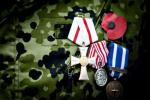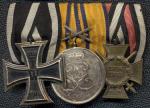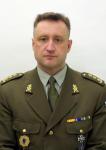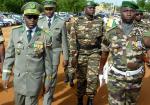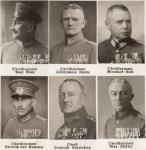-
Posts
4,908 -
Joined
-
Last visited
-
Days Won
97
Everything posted by Dave Danner
-
From what I have: Bühring received the Charakter as a Rechnungsführer on 29.9.1884. He was given the Charakter as a Rechnungsrat on 17.9.1905. He was awarded the Verdienstkreuz in Silber on 19.3.1889 as a Rechnungsführer a.D. Based on his entry in the 1905 Staatskalendar, he later received the Verdienstkreuz in Gold, but I don't have a date. He was awarded the Verdienstmedaille in Silber on 20.2.1883 as a Zeugfeldwebel a.D. Since that is before the Verdienstkreuz, shouldn't that be on the medal bar? Besides the Verdienstkreuz in Gold, the 1905 Staatskalendar also shows the Gedächtnismedaille für Friedrich Franz III. For some reason, the Staatskalendar entries all say Prussian Militärehrenzeichen rather than Allgemeines Ehrenzeichen. The 1866 Erinnerungskreuz is not included in the 1905 list, but it does show up in earlier ones. Here is the 1905 Staatskalendar entry, where he is shown as a member of the supervisory committee of the NCO Widow's Fund. He is not in the 1906 Staatskalendar. These entries are: Verdienstkreuz in Gold Verdienstmedaille in Silber Gedächtnismedaille Friedrich Franz III Militär-Dienstauszeichnung 1. Klasse für Unteroffiziere Prussian Kronenorden 4. Klasse Prussian Militärehrenzeichen (typo for the AEz ?) Baden Gedächtnismedaille für 1849 Kriegsdenkmünze 1870/71 Regards, Dave
-

Heer Bilfinger, Hans Freiherr von
Dave Danner replied to hucks216's topic in Germany: All Eras: Signature Database
His full name was Hans Maximilian Wendel Freiherr von Bilfinger. He was born on 8 May 1886 in Stuttgart, the son of Hermann Freiherr von BIlfinger, the diensttuender Generaladjutant to the King of Württemberg. He was Kommandeur WBK Mannheim I from 1 April 1936 to 29 November 1942. After a brief period in the Führerreserve, he became Kommandant of Stalag V-A on 1 February 1943. He was back in the Führerreserve from December 1944. -
Also, the crown is an integral part for all grades above Knight's Cross (Grand Cross, Commander 1st and 2nd Class, and Officer's Cross). It is only the Knight 1st Class where there is a version with and without crown. I think there is a special class (Sonderstufe) of the Grand Cross where the breast star is in gilt and has a silver crown, but I am not overly familiar with higher grade awards like this. So as a Saxon officer would move up the ranks, he could get: Knight 2nd Class (SA3b / AR2) as a Leutnant/Oberleutnant Knight 1st Class (SA3a / AR1) as a Hauptmann/Rittmeister or Major Crown to the Knight 1st Class (SA3aKr / AR1mK) as a Hauptmann/Rittmeister or Major who already had the Knight 1st Class Officer's Cross (SA3 / AO) as an Oberstleutnant or Oberst Commander 2nd Class (SA2b / AC2) as an Oberst or Generalmajor Commander 1st Class (SA2a / AC1) as a Generalleutnant Grand Cross (SA1 / AG ) as a Generalleutnant or General [the first abbreviation is the standard Prussian/German abbreviation; the 2nd is the Saxon abbreviation found in Saxon rank lists and on cases for Saxon awards] Saxons often skipped the Crown to the Knight 1st Class and/or the Officer's Cross, and sometimes went straight from the Knight 1st Class to the Commander 2nd Class. This is because they often received the Merit Order instead. This is similar to a Prussian alternating between the Red Eagle and the Crown Order, but Prussia seemed more regular than Saxony in this. For example, Otto von Tettenborn received his Knight 1st Class on 21.4.02 as a Major, the Crown to the Knight 1st Class on 16.3.03 while still a Major, the Officer's Cross on 23.5.08 as an Oberst, the Commander 2nd Class on 24.5.11 while still an Oberst (he was promoted to Generalmajor on 23.9.11), the Commander 1st Class with Crown and Swords on 15.9.15 as a Generalleutnant, and the Grand Cross with Swords on 2.8.17 while still a Generalleutnant (char. Gen.d.Inf. on 11.2.18). He received the Knight 1st Class of the Merit Order on 23.5.05 as an Oberstleutnant, the Commander 2nd Class of the Merit Order on 13.9.12, and the Commander 1st Class with Swords of the Merit Order on 4.8.16. Adolf von Carlowitz received the SA3a on 20.4.01 as a Major, the SA3aKr on 11.9.03 as a Major, the SA3 on 24.5.07 as an Oberst, the SA2b on 24.5.10 as an Oberst, the SA2a on 15.1.14 as a Generalleutnant, and the SA1X on 11.5.17 as a General der Infanterie. He received the SV3a on 6.8.04 as an Oberstleutnant, the SV2b on 23.5.12 as a Generalmajor, and the SV2aX on 2.2.15 as a Generalleutnant.
-
Military Police (الشرطة العسكرية)
-
I would have to agree with Paul, though maybe he could be narrowed down. One more non-Prussian award might have helped. Based on the combination of bars, I would say he was most likely in Husaren-Regiment Nr. 8 in the Franco-Prussian War. The first five bars fit certain units of the VII.Armeekorps, mainly in the 13.Division, including HR 8. The "AN DER LISAINE" normally went to Badeners. HR 8 doesn't have a campaign credit for the Lisaine, but it was the only unit in the 13.Division which seems to have been close to the area. A 13.Division affiliation would also fit the last ribbon, as the Westphalian-based division included troops from both Lippe principalities. I quickly looked at HR 8, but I could not find any matches. Most officers in the 1871 rank list with the EK2 also had a Schaumburg-Lippe Military Merit Medal or a Bavarian Military Merit Order. Of those that did not, none appear in the Deutsche Ordens-Almanach with the combination above. Which could mean (1) he wasn't in HR 8, (2) he was already out of HR 8, (3) he was dead before 1909 and doesn't appear in the DOA. Regarding VII.AK units: - HR 8 has all five campaigns/battles - HR 15, FR 39, IR 55, IR 74 and JB 7 don't have Noisseville - IR 13, IR 15 and FR 73 don't have Spichern or Noisseville - IR 53 doesn't have Spichern - IR 77 and FAR 7 have all five, but were in Langres at the time of the Battle on the Lisaine, on the other side of the Haute-Saône Departement. HR 8 was also in the general area, but as a cavalry unit ranged further east, so it could have reached the Lisaine. Regards, Dave
-
Hans-Joachim was his given name. Actually, his full name was Hans-Joachim Wilhelm Ernst von Mellenthin. For some reason, even though double first names are really common in Germany, many sources drop one. Even the navy ranklists just use Hans, so maybe he often went by the shorter name. Oddly, for such a common name, he was the only Hans in the entire von Mellenthin family at the time, so maybe he didn't think he needed to use the "-Joachim". His brother Kurt-Herbert Martin Hermann von Mellenthin is called Kurt-Herbert in the Ehrenrangliste, but just Kurt in the 1918 Rangliste.
-
Size of the state is not the same as importance of the state. Hamburg was the 7th largest state in the Empire, larger than all but the four kingdoms and two of the grand duchies. Bremen was the 13th laregst. Lübeck, while small, was still larger than Mecklenburg-Strelitz, Waldeck, and Schaumburg-Lippe. Lübeck was also larger than each of the Schwarzburg principalities, although they are usually counted together. The Iron Cross always comes first because Prussian regulations placed it first, and Prussian regulations covered every state except Bavaria and Saxony. And Bavarian and Saxon regulations placed the Iron Cross first after their own war decorations. After that, other state awards came in different orders, often by the choice of the wearer. They were ordered by date of award, by type of award (orders, then crosses, then medals, for example), and by the status of the state which awarded them. I think this is what you mean by importance, that is, kingdoms, then grand duchies, then duchies, then principalities, and then Hanseatic cities.
-

Denmark Kingdom of Denmark: Valour Cross
Dave Danner replied to Megan's topic in Northern European & Baltic States
The first recipient, Sgt. Casper Westphalen Mathiesen: And a close-up: Note: click for larger images. The automatic image resizing doesn't seem to tell you when an image can be clicked on. -
The Schwarzburg rolls are being prepared for publication. I have to return to Germany soon to gather some missing information. If you are correct about Rudolstadt, you have a very rare bar. There were only 33 awards of the SEK4X. Awards by year: 1915 - 15 1916 - 8 1917 - 4 1918 - 6 By rank: Feldwebelleutnant - 16 Offizier-Stellvertreter - 11 Oberdeckoffizier - 3 other - 3 (1 Feldhilfsarzt, 1 Feldhilfsveterinär, 1 Feldmagazin-Inspektor) They came from a large number of different units. Only 6 were in IR 96. Five were in 2. Landsturm-Infanterie-Bataillon Gera XI/25. The other 22 were from 22 different units/commands.
-
He likely wouldn't have "done" anything. It was rank-based. Almost every recipient of the SEK4X was a Feldwebelleutnant or Offizier-Stellvertreter, or a Navy equivalent. For what it's worth, swords were often unofficially worn with the Silver Medal for Merit in War, possibly for a Frontkämpfer to distinguish his award from a rear echelon guy. For example:
-
I think they are: 1st bar: EK2, WVKX, FKE, SchlesA2, RAO4 (or Medal of the RAO), PrAEz, Wehrmacht DA25, Wehrmacht DA12, Prussian DA25 2nd bar: EK2, KVK2X, WVKX, FKE, SchlesA2, Wehrmacht DA25, Wehrmacht DA12, Prussian DA25, RAO4, PrAEz, UKEM, BKEM The Silesian Eagle should rank ahead of long service medals, and both bars reflect this. It was improper to wear the Prussian Dienstauszeichnung with the double Wehrmacht Dienstauszeichnungen, but this happened anyway, especially among d.R. or z.V. officers. The two ribbons at 5/6 in the first bar and 9/10 in the second ought not be foreign awards, since they come before the long service awards in the first bar, and as a Beamter he would have been in line for Prussian civil decorations like the Red Eagle Order, Medal of the Red Eagle Order, Allgemeines Ehrenzeichen, and Verdienstkreuz. As peacetime awards of a former German state, they properly come after the long service awards, and the second bar reflects this. As you can see, the last ribbon in the first bar stayed ahead of those two when they moved. This makes me think that it must be another long service, rather than a foreign award or another state award. Given the Württemberg connection, it is possible, but I don't think likely, that the ribbon is for the Medal of the Friedrich Order, awarded before World War I (and before the two Prussian awards). If so, he might have simply placed his Prussian awards ahead of the long service awards out of Prussian pride, and left the peacetime Württemberg award last. But on the second bar, he followed Wehrmacht regulations, and placed the Prussian awards after the long service awards, and in order of date of award.
-

"United States Army Schools" badges
Dave Danner replied to Panzerpionier's topic in United States of America
I believe they are given to foreign graduates of US Army schools. Here, for example, is the current Chief of the Defense Staff of Estonia Colonel Peeter Hoppe. I knew him when he attended the Infantry Officer Advanced Course at Fort Benning in the late 1990s. -
Here is the ribbon bar of Ali Saibou, President of Niger from 1987-1993. His first ribbon is the National Order of Niger (Ordre national du Niger), and the second ribbon is the same as Salou Djibo's 4th one. It looks like the device may be a palm. The rest, starting with the West German Bundesverdienstkreuz in third place (grade: Großes Verdienstkreuz mit Stern), are foreign awards. The first two on the second row may be the French Legion of Honor and National Order of Merit. Not sure about the third. The first one on the third row is the National Order of Mali. Next might be the National Order of Benin, but I'm not sure. The third one looks like the National Order of Vietnam, but that would make no sense, so it is probably another African order. The single yellow ribbon on the third row appears to be the Order of Cameroonian Merit (Ordre du Mérite Camerounais).
-
-
The two medals on Gen. Djibo and the Captain's first one appear to be commemorative or service medals, the Niger equivalent of a General Service Medal. Here is a close-up of Djibo's ribbon bar. As you can see, the 2nd and 3rd ribbons have devices: RCI and ROC. Those would appear to be for the Republic of Côte d'Ivoire and the (Democratic) Republic of the Congo. They match the UN medals - for UNOCI and MONUC - immediately below each.
-
-
The Colonial Decoration (Kolonialauszeichnung), known as the Lion Order, an unoffical award of the Deutsche Kolonialkriegerbund. The combination might be possible for a Saxon NCO and Schutztruppe veteran. In that case the 5th ribbon wouldn't be another Iron Cross, but a Militär-Ehrenzeichen 1st or 2nd Class awarded before World War I. The second ribbon is the Saxon Honor Cross with Swords, which was generally awarded to Saxon NCOs who had 20 years of service or who already had the Silver Friedrich August Medal (3rd ribbon). That does fit with the Saxon long service in 6th place. However, the order of precedence is wrong. The Austrian World War I Commemorative Medal should not be in 4th place, before the other German decorations and the German Honor Cross for Combatants. If anywhere, it should be last. I'm not very knowledgeable on construction, sewing and the like, so I can't say whether the errors are period or if someone just put together a bar with more than a little, but maybe not enough, knowledge. Maybe someone with more knowledge in this area could add his two cents.
-

German State Hindenburg Cross question
Dave Danner replied to tuomaskoivurinne's topic in State, Civil Awards & Decorations
F. & B.L. is Funcke & Brüninghaus, Lüdenscheid. Your's looks like it is zinc or steel, which is not common (most were bronze), but they are not very rare. -
Odulf, regarding your gap: there were no regulations in the Weimar Republic, so "anything goes" was the rule, especially for civilians. Active Reichswehr members mainly followed the rules of their former army, so Prussians (and other citizens of most other states within the Prussian Army) followed Prussian rules, Bavarians followed Bavarian rules, and Saxons followed Saxon rules. But even here, there were lots of variations. For example: 1. Paul Platz, a Badener, has mixed Baden/Prussian precedence, then non-Prussian awards. 2. Friedemann Goetze, a Prussian, places his non-Prussian war decorations before his Prussian peacetime awards. 3. Bernhard Rust, a Bavarian, has his Bavarian MVO before the EK2, following Bavarian precedence, but his Saxon Albert Order with Swords ahead of the Bavarian Jubilee, which was not the Bavarian regulation (the Jubilee/PRLM came after the EK2 but before non-Bavarian awards). 4. Heinrich von Kummer, a Prussian, follows standard Prussian precedence. His Hamburg Hanseatic Cross comes before his Lübeck Hanseatic Cross, but I have no idea whether this is based on size, award date, or alphabetical order. The peacetime Order of the Griffin comes last. 5. Friedrich Salzenberg, a Prussian, follows standard Prussian precedence, but for his non-Prussian awards, the order is odd: BMV3X, WK3X, SA3aXKr, SA3aKr, BremH. This places a peacetime Saxon award before a wartime Bremen award. 6. Max Fiedler, a Saxon, follows Saxon precedence: Saxon war decorations, then EK2, then other Saxon (his Saxon DA), then non-Saxon (his RAO4).
-
There was no official order of wear. I think order of issue would be more likely than not, especially for co-equals like the three city states. For other combinations of state awards, sometimes alphabetically, sometimes order of issue, and sometimes by rank (kingdoms first, then grand duchies, duchies, principalities, and city states). Sometimes just personal (for example home state first) or aesthetic preference (for example crosses before medals). Prussian regulations had Prussian decorations first, but other states were by personal preference. There were no Weimar regulations. Wehrmacht regulations during World War II placed certain high decorations first, and then other state awards usually in order of issue.
-
Here is a perfectly normal bar with a peacetime SEHO and no wartime award from a Saxon duchy. In this case, the recipient was a Stabsarzt. He entered active duty in 1898, so no Centenary, and apparently did not reach 25 years before leaving the service, so no DA. So it is quite possible, if not common. You would be looking for an active officer, since a reserve or Landwehr officer would likely have the LD2. He would have gotten the SEHO before the war, possibly while serving in a regiment with a Saxon connection, and been in a Hesse regiment during the war. Another possibility is a recalled regular officer, who entered service after 1897, got the SEHO around the ten year mark, and then retired and moved to somewhere like Darmstadt or Giessen. That said, I think it is just as likely that someone removed a wartime SEHO with swords, as Claudius suggests.





